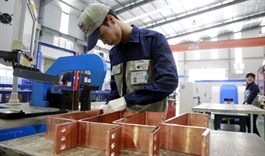It’s never too late to optimise M&A value
It’s never too late to optimise M&A value
Mergers and acquisitions can be an effective strategy to increase business value. Unfortunately, many transactions do not deliver their expected benefits due to a variety of breakdowns in the merger and integration process. Le Khanh Lam, tax partner at RSM Vietnam, explains how, by focusing on operational and process improvement, it is not too late to drive significant value to the organisation.

Le Khanh Lam, tax partner at RSM Vietnam
|
Organisations have the best intentions and normally develop a global strategy when approaching a merger or acquisition (M&A). Short cuts, limited resources and potential missteps can cause a merger integration to produce a diminished return on investment. The merger process often deteriorates if the strategy is not documented or linked to the integration plan, or if implementation is poorly managed.
These issues are not limited to small- and medium-sized businesses. Even large companies often focus on tackling high-priority items, but overlook crucial details. If left unattended too long, what were once minor issues can become major concerns with the potential to derail integration and the expected benefits. Whether it has been six months or six years since the completion of a transaction, these issues can be rectified to further optimise deal value.
Realising the value of an M&A starts with a comprehensive strategy and progresses to define the structure of the new, combined entity. Integration planning should start with determining whether the company has the right structure in place to effectively integrate operations. The process then continues to identify what systems, processes, staffing and roles will support the future, integrated business model moving forward in an efficient, scalable way. Taking a holistic, strategic approach to integration is critically important if the company wants to continue pursuing add-on acquisitions.
Many mergers are hampered by inefficiency and redundancy when the two firms continue conducting business with different approaches while processes should be standardised and organisations aligned.
Known pitfalls
Several common issues arise during the merger process that can directly lead to diminished value. If any of these situations exist within your organisation, they should be recognised and addressed or they will limit the benefits realised due to missed opportunities. Depending on the capabilities of the organisation, these problems may be addressed internally.
Many companies simply do not possess the bandwidth to perform an effective integration with internal staff. Internal employees chosen to perform critical integration tasks are typically high performers with multiple roles within the company. It is not that they do not have the knowledge or skills to work through issues – rather, they find it difficult to manage these additional responsibilities while continuing to perform their daily jobs.
Finding enough internal resources with experience and availability in managing complex integration projects provides further challenges and risks to integration efforts. Experienced integration consultants may provide an objective perspective and project resources to accelerate the benefits of integration.
There are some situations, especially in significant mergers, where companies will intentionally operate separately and retain current systems and procedures. Many of the existing departments and systems that are in place when the merger is initiated are retained and may not merge or integrate. Some integration points may be explored, such as how to leverage a common distribution channel to drive revenue growth, but many major areas involving back office and support functions largely remain the same.
Today, economic pressures are rising and many companies must find ways to create more value and efficiency out of their business. The remaining areas for integration are prime targets. Unfortunately, as more time passes after a merger, the more difficult integration may become. After spending time operating separately, pulling infrastructure and people together is often a significant challenge and in some cases requires breaking through cultural barriers.
Following a presidential inauguration, there is a window of opportunity, a 100-day honeymoon period where the public expects change. A similar scenario exists following a transaction. Employees often have a new energy, are eager to see what is going to happen and are engaged in the process. If that moment passes, and integration decisions are put on hold, it becomes more difficult to implement change in culture and processes down the road.
Sometimes acquisitions are straightforward, as one company is absorbed into the acquirer’s practices. However, in many situations involving M&A, internal politics and other influencing factors can cause delays and result in significant pains. The unfortunate reality is that additional value and benefits may not occur if integration is delayed.
On the other hand, some businesses attempt to initially undertake too much integration at once. Some executives are determined to integrate everything on day one. Snap decisions can be as damaging to the value of a transaction as delaying integration. To meet the demands of a growing business, it is critical that integration is planned and implemented holistically. Insightful planning should be completed to identify improvements in processes, systems and roles.
Organisations should not delay integration indefinitely, but an appropriate amount of time must be invested to ensure that the integrated process is pragmatic. The integration decisions should be based on proven rationale for the newly merged functions and in alignment with an effective business strategy.

A company that takes the initiative in integration often enjoys easier processes and financial victories
|
Not just about integrating
Many companies consider integration to be solely about data and technology systems. It is perceived that as long as a common system is in place, the businesses are sufficiently integrated. Good data, well-aligned processes, and clear roles and responsibilities – along with a common platform – are essential to operating optimally.
If departments, locations or business units are utilising different business processes and practices, common problems arise from disjointed operations and compromised communications that do not align with strategic goals. Ensure your business is taking a holistic and effective view of organisational and operational integration.
Another common situation is illustrated when a business grows organically and through multiple acquisitions, but fails to build scalable integrated operating capabilities. The result is a larger organisation, but one that lacks the operational capacity and efficiencies that are required by a larger enterprise. Relatively immature and inefficient operational capabilities add significant risk and complexity in supporting the company’s further growth plans. Lack of timely integration may result in problems and excessive costs from processes unable to handle the increased volume.
In the case of large M&A deals, it is critical for leaders of both companies to agree on strategy and direction of the combined company as delays can be expensive. If disagreements occur over roles, who stays and goes, and business practices and systems, the company will languish and profits will be at risk.
Emotions and politics sometimes complicate the process as people try to protect their own interests rather than making the best decisions for the combined company. Employees understandably become attached to processes and support tools, making change difficult. However, these political and cultural barriers must be overcome and managed in a timely manner. In this situation, an outside partner could provide the objective advice and help needed to make the difficult decisions while keeping the company’s best interests in mind.
Integration may become more daunting and expensive as each day passes. The company could save costs by integration and streamlining of its warehouse operations, inventory management, back-office functions, supply chain vendors and other functions. Many companies do not have the foresight to estimate those potential savings. They often continue with business as usual and do not determine the financial impact before and after the M&A. In the end, did they achieve their growth goals?
A company that initiates integration in a timely fashion often faces a much easier process with quick economic wins. The staff expects change and is amicable to it, and severance packages are often seen as appropriate and generous early in a transition. A professional, efficient integration process can deliver timely and significant value to the new, combined company.
In a prolonged, struggling merger, the combination of unrealised savings, lower employee morale due to uncertainty and an unclear operational strategy can weigh an organisation down and limit its ability to innovate and respond to opportunities in the market. It can also have an impact on the customer base if end-to-end processes are disjointed or if there are mistakes in areas such as billing and shipping. Your employees are the first line to your customers. If employees are unhappy, it is likely being communicated to customers or even to competitors.
While cultural implications may exist, the key business impact in delaying integration is definitely financial. By accelerating integration where it makes strategic sense, you can accelerate the financial returns.
There is a reason that companies agree to an M&A in the first place. However, for the integration to be successful, executives must work together and redefine the new company. When the potential is not fully realised, operational and financial benefits may evaporate. At best, a failed integration results in financial losses and decreased employee morale, while a worst-case scenario is that the company’s future is at risk.
Whether an integration delay is due to a strategic decision or unintended circumstances, it is never too late to work towards optimising integrated operating capabilities and realising the benefits of a merger or acquisition. In fact, the best companies continue to identify tactics to further integrate and realise more value from a transaction. An experienced advisor can help objectively evaluate people, processes, and technology to discover more integration opportunities that will drive increased financial returns and position the organisation to effectively support plans for future growth.



























